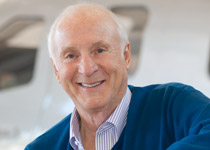Would you really like to experience a piece of history? Author Barry Schiff says he did just that when he flew a 1928 Sikorsky flying machine (see " The Flying Boat," page 62)." Taking off and landing from remote corners of Lake Mead in southern Nevada where there are no reminders of twenty-first-century civilization, I could almost believe that the Sikorsky seaplane had transported us in time and distance to provide some of the conditions experienced by those who paved the way," Schiff says. "It was the next best thing to having a time machine and actually having been there."
Writer Phil Scott has logged time in nearly 30 different types of airplanes (unless you don't count the Cessna 150 and 152 as separate types), but he's never flown anything without an engine — until he went to Kitty Hawk, North Carolina (see " Hanging Around," page 78). "I can't think of a better place to master unpowered flight," he says. "And I'll keep going back there until I do." Scott is the author of five books, most recently The Wrong Stuff: Attempts at Flight Before (and after) the Wright Brothers.
Driver's license? Check. Social security number? Check. Badge? Check. That, and an express invitation, was all it took editor at large Tom Horne to attend the FAA's formal commissioning ceremonies for the Wide Area Augmentation Service (WAAS). (See " GPS Goes Low," page 71.) The press conferences came first, but the main event of the day was a visit to the FAA equivalent of the Air Force's Cheyenne Mountain Missile Operations Center. Down the hall, a left, a right, through the fireproof doors, and there it was — the cavernous, darkened room that is the Air Traffic Control System Command Center in Herndon, Virginia. "It was like the War Room scene in Dr. Strangelove," Horne says. "Huge screens monitoring satellite status here, air traffic there, delays there, weather systems on another screen — the whole U.S. airspace system, plus the oceanic areas. The room was hushed, yet there was stress in the calm. Marion Blakey, the FAA administrator, was touring the facility too. She sat down on a chair at the operations and maintenance console, turned to a nervous staffer and asked, 'What's that do?' The poor guy was nervous. You should have seen his face. Then he opens his mouth and a bunch of ancronyms come flying out. I didn't understand them. Don't think Blakey did either, but she was polite about it."
There's more that goes on at the World Aerobatic Championships than meets the eye. Competitors take it seriously, as Al Marsh found out in mid-July when he attended the competition in Lakeland, Florida (see " Flying the Schnozz," page 92). The Russian team arrived in the United States 10 days early and went to Tucson to practice. The Russians get government support, as does the French team. American team members must raise much of the funds themselves to compete at the world level (although several sponsors have stepped forward) and steal time from their jobs and family for daily practice. The only Canadian team member, Toronto native Doug Jardine, built up a contracting business over 20 years for the sole purpose of supporting his aerobatic passion and representing his country.



